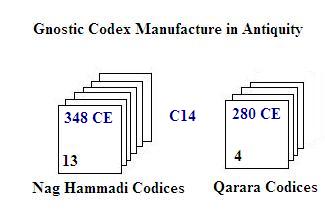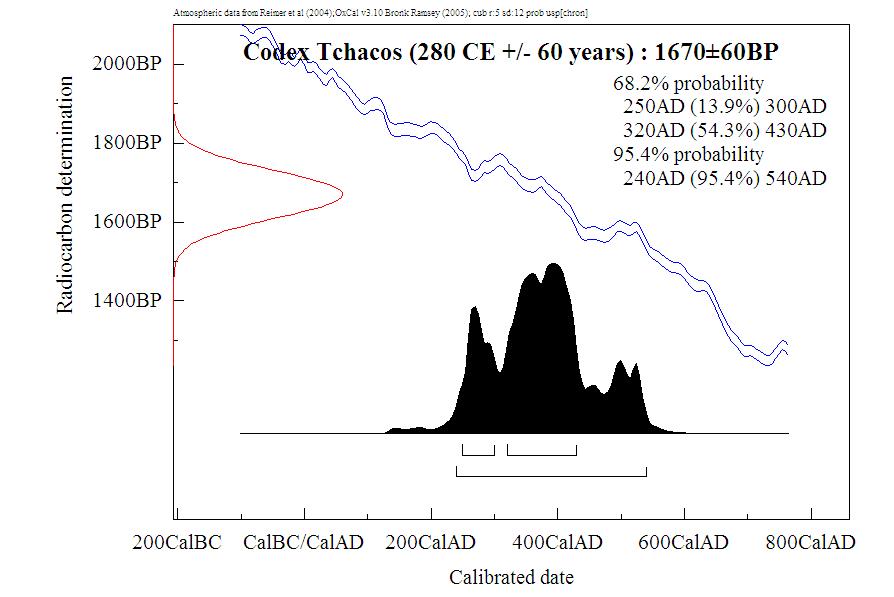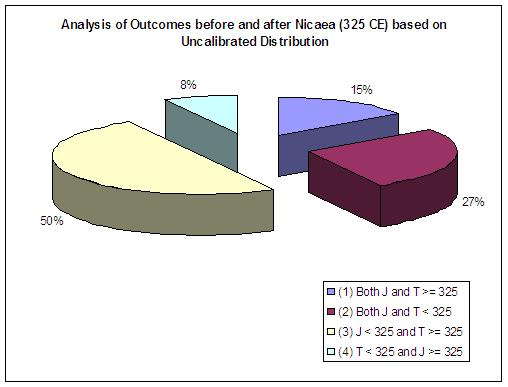
 |
Freethought & Rationalism ArchiveThe archives are read only. |
|
|||||||
|
|
Thread Tools | Search this Thread |
|
|
#181 |
|
Contributor
Join Date: Mar 2006
Location: Falls Creek, Oz.
Posts: 11,192
|
Radiocarbon Dating the Gnostics after Nicaea .
 After prolonged discussions in a number of science forums, and email exchanges with ANSTO, I have summarised a series of information items in this article by which it is argued that as a result of the C14 analysis, it is reasonable to suspect that the production and manufacture of codices containing "Gnostic Gospels and Acts" etc occurred after the Council of Nicaea. Here is a revised composite graph in respect of the uncalibrated radiocarbon age estimates provide via C14 tests for the Gospel of Judas and the Gospel of Thomas (NHC 2.2).  The Effect of Radiocarbon Calibration It should be noted that the uncalibrated radiocarbon age result above represents the penultimate step in the C14 process. The final step required in the C14 dating process is to take this uncalibrated radiocarbon age, and to "calibrate" it against the known and continuously refined radiocarbon calibration curve, which has the impact of moving the entire uncalibrated age distribution forward substantially. Here is a graph of the radiocarbon calibration of the 280 CE "radiocarbon age" result published for the Gospel of Judas. This graph was prepared by OxCal software, with the 280 and range as input data.  As can be clearly seen, while the uncalibrated range is between 220 and 340 CE (shown as the red curve at the upper LHS), the calibrated range (multi-peaked curve) is now between 240 and 540 CE. Gnostic Codex Manufacture as Post Nicaean The results above are in respect of the radiocarbon dating analyses on codices which contain "Gnostic Gospels" and other gnostic material and which are presumed to have been manufactured by Gnostics (whoever they were). The novelty here is that the C14 is saying that the codex production of these Gnostics is focussed chrobologically after Nicaea. Was the Authorship of the Gnostic Gospels contemporaneous with Publication? Everyone conjectures that the "original authorship" for these two Gnostic Gospels was in the second century, on the basis of citations to their existence by Eusebius and other authors over which the Nicaean Church had control (such as Tertullian). If the "Gnostic Gospels" were in fact a reaction to the Nicaean supremacy of the new testament canon, then it would be expedient if this conjecture is seriously re-examined in the light of the C14 results. My argument is that the manuscript discoveries of Nag Hammadi and the Tchacos Codex (gJudas etc) represent discoveries of original authorship which needed to get published in the momentous and revolutionary rule of Constantine, when the "new and strange" Christian State Religion sought to rule supreme over the ostensibly pagan milieu of religions (and academies) in the Roman Empire, especially around Alexandria in Egypt from 324 CE onwards. |
|
|
|
|
#182 | ||
|
Contributor
Join Date: Mar 2006
Location: Falls Creek, Oz.
Posts: 11,192
|
 Combinatorial Probabilistic Analysis Where J is the uncalibrated radiocarbon "age" date of the Gospel of Judas (ie: 280 CE plus or minus 60 years) and T the date of Thomas (ie: 348 CE plus or minus 60 years), then there are only 4 possible arrangments as follows ... The odds that both codices were manufactured after Nicaea (325 CE) are not as long as many might initially presume. Quote:
|
||
|
|
|
|
#183 | |
|
Contributor
Join Date: Mar 2006
Location: Falls Creek, Oz.
Posts: 11,192
|
Quote:
My position is that the invalid claims that keep popping up in regard to the Gnostics were first invented by the "church fathers" also known as the orthodox heresiologists (such as Eusebius) of the 4th century. With recent archaeological finds we are only just beginning to analyse the original manuscripts and codices that the gnostics manufactured. There is a great gulf between what the "church fathers" wrote about their bitter enemies - the vile gnostics - and what the gnostics themselves write about. How many invalid claims have we seen here that are openly recognised to be originated with these same "church fathers"? Rejecting Eusebius as a reliable guide to the chronology of the noncanonical gospels etc Rejecting Eusebius (et al) as a reliable guide to the new testament canon is not being considered here at all. The discussion here is about rejecting Eusebius as a reliable guide to the chronology of the new testament non canonical literature, and seeing what logically develops from that point. |
|
|
|
|
|
#184 | |||
|
Contributor
Join Date: Mar 2006
Location: Falls Creek, Oz.
Posts: 11,192
|
Quote:
Quote:
In any event, he highlights the weakpoint of the HJ hypothesis. Quote:
|
|||
|
|
|
|
#185 |
|
Junior Member
Join Date: Mar 2006
Location: Atlanta
Posts: 96
|
He also commented that the Gospels are given more weight because they are generally recognized as earlier documents. He understood, and didn't disagree with that.
|
|
|
|
|
#186 | |
|
Contributor
Join Date: Jun 2000
Location: Los Angeles area
Posts: 40,549
|
Quote:
On the gnostic gospels and apocryphal acts: Carrier is attacking the case made by HJ academics, which is generally based on treating the gospels and Acts as historical. Since no one even tries to find any history in the gnostic gospels, I doubt that he will spend much time on them. |
|
|
|
|
|
#187 | |||
|
Contributor
Join Date: Mar 2006
Location: Falls Creek, Oz.
Posts: 11,192
|
Quote:
Mentioned here ... Quote:
It appears that Carrier rules out the possibility that the apocyphal stuff as being a post Nicaean literary phenomenom, along with everyone else. Quote:
The gnostic gospels and acts are not the "background" to the orthodox canonical gospels and acts, its completely the other way around, since the gnostics are clearly known to have imitated the canonical gospels and acts. I think Carrier is setting off to write about the "Historicity of Jesus" and has simply relegated the gnostic gospels and acts into the "Apocyrpha Basket", where "The Ascension of Isiah" and the "Acts of Pilate" rest side by side. The actual chronology of the non canonical books is being addressed just like a background assumption, which becomes explicit in Eusebius, but which is being questioned by the recent C14 results. Sure, it is quite possible that the Gospel of Judas and the Gospel of Thomas were not authored after Nicaea by people who competed with Constantine for the entertainment of the Greek speaking populace, but were inserted into 4th century codices by scribes for their anonymous preservation. How many 4th century C14 citations will it take? How many 4th century C14 citations on gnostic gospels and acts etc will it take for the general person to start questioning whether we are dealing with original 4th century texts? I'd like to ask any readers how many C14 citations would it take to convince you of this possibility? |
|||
|
|
|
|
#188 |
|
Junior Member
Join Date: Mar 2006
Location: Atlanta
Posts: 96
|
I don't remember when. I listened to the whole interview. I remember him saying that somewhere in there.
|
|
|
|
|
#189 | |
|
Contributor
Join Date: Jun 2000
Location: Los Angeles area
Posts: 40,549
|
Quote:
|
|
|
|
|
|
#190 | |
|
Veteran Member
Join Date: Jul 2008
Location: Location: eastern North America
Posts: 1,468
|
Quote:
The date ranges obtained from C14 studies, are useful primarily for excluding a date of origin prior to the earliest date in the range, but do not assist us in specifying with precision the actual date of composition, itself, because the particular subset of documents analyzed could potentially all represent copies, duplicated from templates of much earlier origin, rather than original manuscripts, themselves. Similarly, the text could have been written on plant material hundreds of years after the living plant had been harvested. We can feel comfortable knowing that the particular document under investigation was created from approximately the time period corresponding to the date of the plant material, but we cannot claim to know, in my opinion, from the age of the plant material, the date of composition of the original treatise itself. avi |
|
|
|
| Thread Tools | Search this Thread |
|